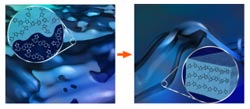Low-Priced Plastic Photovoltaics

Imperial College/S. Wood & J. Bailey<br><br>The polymer blend morphology without (left) and with (right) nanowires. <br>
Photovoltaic devices, which tap the power of the sun and convert it to electricity, offer a green — and potentially unlimited — alternative to fossil fuel use. So why haven’t solar technologies been more widely adopted?
Quite simply, “they’re too expensive,” says Ji-Seon Kim, a senior lecturer in experimental solid-state physics at Imperial College London, who, along with her colleagues, has come up with a technology that might help bring the prices down.
The scientists describe their new approach to making cheaper, more efficient solar panels in a paper in The Journal of Chemical Physics, produced by AIP Publishing.
“To collect a lot of sunlight you need to cover a large area in solar panels, which is very expensive for traditional inorganic — usually silicon — photovoltaics,” explains Kim. The high costs arise because traditional panels must be made from high purity crystals that require high temperatures and vacuum conditions to manufacture.
A cheaper solution is to construct the photovoltaic devices out of organic compounds—building what are essentially plastic solar cells. Organic semiconducting materials, and especially polymers, can be dissolved to make an ink and then simply “printed” in a very thin layer, some 100 billionths of a meter thick, over a large area. “Covering a large area in plastic is much cheaper than covering it in silicon, and as a result the cost per Watt of electricity-generating capacity has the potential to be much lower,” she says.
One major difficulty with doing this, however, is controlling the arrangement of polymer molecules within the thin layer. In their paper, Kim and colleagues describe a new method for exerting such control. “We have developed an advanced structural probe technique to determine the molecular packing of two different polymers when they are mixed together,” she says. By manipulating how the molecules of the two different polymers pack together, Kim and her colleagues created ordered pathways — or “nanowires” — along which electrical charges can more easily travel. This enables the solar cell to produce more electrical current, she said.
“Our work highlights the importance of the precise arrangement of polymer molecules in a polymer solar cell for it to work efficiently,” says Kim, who expects polymer solar cells to reach the commercial market within 5 to 10 years.
The article, “Understanding the Relationship between Molecular Order and Charge Transport Properties in Conjugated Polymer Based Organic Blend Photovoltaic Devices” by Sebastian Wood, Jong Soo Kim, David T. James, Wing C. Tsoi, Craig E. Murphy and Ji-Seon Kim appears in The Journal of Chemical Physics. See: http://dx.doi.org/10.1063/1.4816706
The authors of this manuscript are affiliated with Imperial College London, National Physical Laboratory in the United Kingdom, KAIST in the Republic of Korea.
ABOUT THE JOURNAL
The Journal of Chemical Physics publishes concise and definitive reports of significant research in the methods and applications of chemical physics. See: http://jcp.aip.org
Media Contact
More Information:
http://www.aip.orgAll latest news from the category: Materials Sciences
Materials management deals with the research, development, manufacturing and processing of raw and industrial materials. Key aspects here are biological and medical issues, which play an increasingly important role in this field.
innovations-report offers in-depth articles related to the development and application of materials and the structure and properties of new materials.
Newest articles

Silicon Carbide Innovation Alliance to drive industrial-scale semiconductor work
Known for its ability to withstand extreme environments and high voltages, silicon carbide (SiC) is a semiconducting material made up of silicon and carbon atoms arranged into crystals that is…

New SPECT/CT technique shows impressive biomarker identification
…offers increased access for prostate cancer patients. A novel SPECT/CT acquisition method can accurately detect radiopharmaceutical biodistribution in a convenient manner for prostate cancer patients, opening the door for more…

How 3D printers can give robots a soft touch
Soft skin coverings and touch sensors have emerged as a promising feature for robots that are both safer and more intuitive for human interaction, but they are expensive and difficult…





















